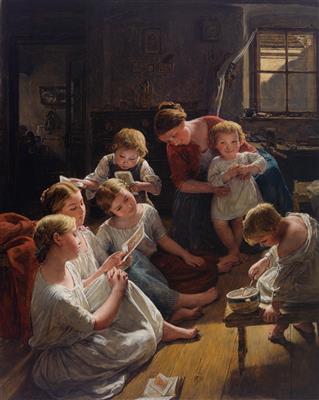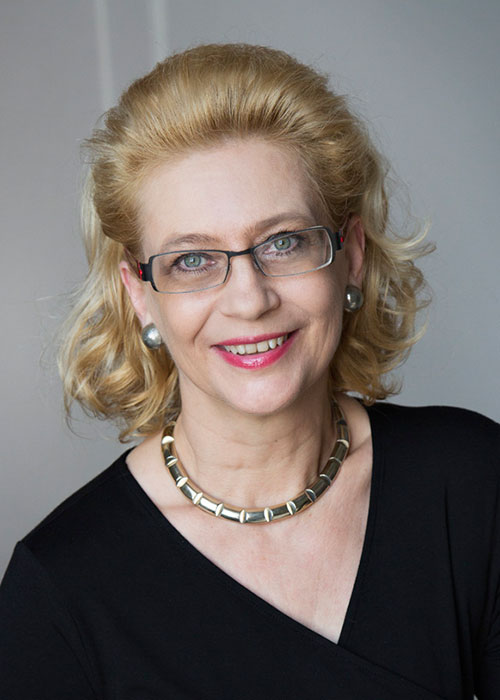Ferdinand Georg Waldmüller

(Vienna 1793–1865 Hinterbrühl)
Children in the morning looking at pictures, signed,
dated Waldmüller 1853, oil on panel, 55.5 x 44 cm,
convex (formerly cradle removed), framed.
Provenance:
Sale Neumeister Munich, 18 March 1992, lot 680
Listed and reproduced in:
Rupert Feuchtmüller, Ferdinand Georg Waldmüller (1795–1865), Leben, Schriften, Werke, Verlag Christian Brandstätter, Österreichischen Galerie, Vienna 1996, p. 504, no. 863.
Exhibited: Compare:
CR no. 1019. Replica of 1860.
A copy of the expertise
by Prof Dr Rupert Feuchtmüller, 12 April 1992, is available. Prof Rupert Feuchtmüller thus writes in his expertise: (...) “According to current knowledge, it is in this painting, reproduced here, that one finds the first execution of this theme. Personally, I regard this as one of Waldmüller’s most convincing child portraits. The plasticity of the group, enhanced by the sunlight, also inspired the interest of contemporary art critics. Thus, on the occasion of the Dresden exhibition in 1861, the ‘Breslauer Zeitung’ wrote the following about the painting ‘Kinder, welche Bilder betrachten’ [Children Contemplating Pictures]: “Here it is real sunlight, which shines on these, for the most part, ever so charming, young creatures, and the whole representation is of such a kind that we can hardly name a picture in the whole exhibition, which we would rather possess.” (From the certificate of Professor Rupert Feuchtmüller, Fuschl, 12 April 1992)
Ferdinand Georg Waldmüller
Waldmüller was born in 1793 as the only child of Georg Waldmüller and his wife Maria Elisabeth. He already left the parental home at the tender age of fourteen, in order to study at the Academy in Vienna from 1807 until 1813, against the wishes of his mother. There he was the pupil of Johann Baptist Lampi, among others.
At first, Waldmüller earned his keep as a portraitist and miniaturist, and in 1811 became a teacher of drawing at the town theatre in Agram (Zagreb), where he also met his future wife, the Court Opera singer Katharina Weidner.
After the married couple had lived in various towns, including Baden near Vienna, Brno, and Prague, they settled in Vienna in 1817, where, with the exception of a few travels – especially to Italy – Waldmüller was to remain. In 1818 Waldmüller took lessons from Johann Nepomuk Schödlberger, and – inspired by his teacher – turned his attention to nature studies and landscape painting. Initially, however, his most successful branch was to remain portrait painting, as an 1822 exhibition in St. Anna testifies. In 1829 he became curator of the gallery at the Academy of Fine Arts in Vienna, and, as professor, taught “Foundations of Painting”. He undertook his first trip to Paris in 1830, and – inspired by the painting there – engaged intensively with landscape painting from then on. In the following years, he painted landscapes of the Salzkammergut, where he stayed in the summer, and of the Viennese Prater. In 1835 he was appointed to the Academy Council.
Yet already in the mid-1830s, at the pinnacle of his career, Waldmüller increasingly came into conflict with the Academy. He was accused of giving private lessons according to his own methods, alien to the Academy. Additionally, “painting from nature” was “incompatible with the Academy’s method of teaching”.
Chancellor Metternich supported and protected Waldmüller, but, ultimately, could not prevent the rejection of Waldmüller’s proposals for reform, leading, in the first instance, to the loss of his atelier at the Academy in 1850. In 1851 Waldmüller married Anna Bayer, who was 33 years his junior. In spite of his great success abroad, for example, at the World Exhibition in Paris, or at his exhibition at Buckingham Palace in London, Waldmüller’s financial situation was strained. In 1857 he published another polemic, in which he even called for the closure of the Academy. Consequently, Waldmüller was suspended, followed by forced retirement on half-pay, which, in an act of clemency, was raised to the standard level by Emperor Franz Joseph in 1864.
Ferdinand Georg Waldmüller died in 1865, aged 72, as one of the most important Austrian painters of the 19th century. (Lit. Rupert Feuchtmüller, Ferdinand Georg Waldmüller, Vienna 1996; Gerbert Frodl/Klaus Albrecht Schröder, Wiener Biedermeier, Munich 1992.)
Esperta: Mag. Dimitra Reimüller
 Mag. Dimitra Reimüller
Mag. Dimitra Reimüller
+43-1-515 60-355
19c.paintings@dorotheum.at
10.05.2017 - 17:00
- Stima:
-
EUR 400.000,- a EUR 500.000,-
Ferdinand Georg Waldmüller
(Vienna 1793–1865 Hinterbrühl)
Children in the morning looking at pictures, signed,
dated Waldmüller 1853, oil on panel, 55.5 x 44 cm,
convex (formerly cradle removed), framed.
Provenance:
Sale Neumeister Munich, 18 March 1992, lot 680
Listed and reproduced in:
Rupert Feuchtmüller, Ferdinand Georg Waldmüller (1795–1865), Leben, Schriften, Werke, Verlag Christian Brandstätter, Österreichischen Galerie, Vienna 1996, p. 504, no. 863.
Exhibited: Compare:
CR no. 1019. Replica of 1860.
A copy of the expertise
by Prof Dr Rupert Feuchtmüller, 12 April 1992, is available. Prof Rupert Feuchtmüller thus writes in his expertise: (...) “According to current knowledge, it is in this painting, reproduced here, that one finds the first execution of this theme. Personally, I regard this as one of Waldmüller’s most convincing child portraits. The plasticity of the group, enhanced by the sunlight, also inspired the interest of contemporary art critics. Thus, on the occasion of the Dresden exhibition in 1861, the ‘Breslauer Zeitung’ wrote the following about the painting ‘Kinder, welche Bilder betrachten’ [Children Contemplating Pictures]: “Here it is real sunlight, which shines on these, for the most part, ever so charming, young creatures, and the whole representation is of such a kind that we can hardly name a picture in the whole exhibition, which we would rather possess.” (From the certificate of Professor Rupert Feuchtmüller, Fuschl, 12 April 1992)
Ferdinand Georg Waldmüller
Waldmüller was born in 1793 as the only child of Georg Waldmüller and his wife Maria Elisabeth. He already left the parental home at the tender age of fourteen, in order to study at the Academy in Vienna from 1807 until 1813, against the wishes of his mother. There he was the pupil of Johann Baptist Lampi, among others.
At first, Waldmüller earned his keep as a portraitist and miniaturist, and in 1811 became a teacher of drawing at the town theatre in Agram (Zagreb), where he also met his future wife, the Court Opera singer Katharina Weidner.
After the married couple had lived in various towns, including Baden near Vienna, Brno, and Prague, they settled in Vienna in 1817, where, with the exception of a few travels – especially to Italy – Waldmüller was to remain. In 1818 Waldmüller took lessons from Johann Nepomuk Schödlberger, and – inspired by his teacher – turned his attention to nature studies and landscape painting. Initially, however, his most successful branch was to remain portrait painting, as an 1822 exhibition in St. Anna testifies. In 1829 he became curator of the gallery at the Academy of Fine Arts in Vienna, and, as professor, taught “Foundations of Painting”. He undertook his first trip to Paris in 1830, and – inspired by the painting there – engaged intensively with landscape painting from then on. In the following years, he painted landscapes of the Salzkammergut, where he stayed in the summer, and of the Viennese Prater. In 1835 he was appointed to the Academy Council.
Yet already in the mid-1830s, at the pinnacle of his career, Waldmüller increasingly came into conflict with the Academy. He was accused of giving private lessons according to his own methods, alien to the Academy. Additionally, “painting from nature” was “incompatible with the Academy’s method of teaching”.
Chancellor Metternich supported and protected Waldmüller, but, ultimately, could not prevent the rejection of Waldmüller’s proposals for reform, leading, in the first instance, to the loss of his atelier at the Academy in 1850. In 1851 Waldmüller married Anna Bayer, who was 33 years his junior. In spite of his great success abroad, for example, at the World Exhibition in Paris, or at his exhibition at Buckingham Palace in London, Waldmüller’s financial situation was strained. In 1857 he published another polemic, in which he even called for the closure of the Academy. Consequently, Waldmüller was suspended, followed by forced retirement on half-pay, which, in an act of clemency, was raised to the standard level by Emperor Franz Joseph in 1864.
Ferdinand Georg Waldmüller died in 1865, aged 72, as one of the most important Austrian painters of the 19th century. (Lit. Rupert Feuchtmüller, Ferdinand Georg Waldmüller, Vienna 1996; Gerbert Frodl/Klaus Albrecht Schröder, Wiener Biedermeier, Munich 1992.)
Esperta: Mag. Dimitra Reimüller
 Mag. Dimitra Reimüller
Mag. Dimitra Reimüller
+43-1-515 60-355
19c.paintings@dorotheum.at
|
Hotline dell'acquirente
lun-ven: 09.00 - 18.00
kundendienst@dorotheum.at +43 1 515 60 200 |
| Asta: | Collezione Reinhold Hofstätter |
| Tipo d'asta: | Asta in sala |
| Data: | 10.05.2017 - 17:00 |
| Luogo dell'asta: | Wien | Palais Dorotheum |
| Esposizione: | 05.05. - 10.05.2017 |
Altri oggetti dell'artista
-

Stima:
EUR 35.000,- a EUR 45.000,- -

Stima:
EUR 18.000,- a EUR 25.000,- -

Stima:
EUR 12.000,- a EUR 18.000,-
